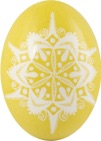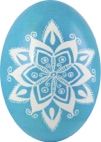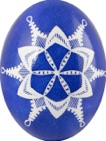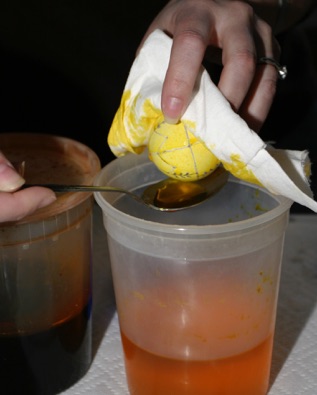Snowflake Pysanka
Step-by-Step: Simple Dyeing
Snowflake Pysanka
Step-by-Step: Simple Dyeing

Once I’ve completed waxing in the snowflake, and removed the pencil marks, it is time to dye the egg its final color. Unless I am making a red and brown egg snowflake, or a large, intricate snowflake, dyeing is fairly straightforward, resulting in a WHITE snowflake on a simple monochromatic COLORED background.
Jewel Tones: Many of the backgrounds of my snowflake pysanky are simple jewel-tone solids. These give a very nice effect, and are my preferred dye choice. Just look at the garnet, amethyst, ruby, topaz, aquamarine and sapphire tones here:






The dyes used to achieve these colors were UGS Red, PS Magenta, UGS Scarlet, EC Gold, UGS Light Blue and UGS Royal Blue. Many other dyes will give you similarly beautiful colors, including UGS Red Mix (Red + Scarlet), UGS Eggplant (Red + Purple), Citrine (UGS Yellow + 3 T Light Green), Orange, Dark Green and others.
Dye as you would any other egg. Make sure it is clean and all stray pencil lines have been removed, dip it briefly into a vinegar rinse, and then dye your desired color.
Pastels: Snowflake pysanky also look quite nice with a pastel finish. Because aniline dyes take quite quickly, adjusting dyeing times (i.e. dipping very quickly) is not a good way to get a pastel color. What works better is adding 1 or 2 tablespoons of prepared dye to a cup of water, along with a tablespoon of vinegar, and using that dye solution.


The two snowflake pysanky pictured here were dyed with pastel purple and pink; similarly nice results can be obtained by diluting light blue, turquoise, and other colors. This more intricate snowflake pysanka uses several different pastels to nice effect:

I personally prefer the jewel tones, as they seem more wintry and bold; to me, pastels are spring colors, and more appropriate for holidays associated with the vernal equinox.
Not all eggshells are perfect, though. While most eggs will take dye evenly, and give lovely results like those above, others, when dyed, will be found to have scratches, abrasion rings, or areas with poor or uneven dye adherence. When making ordinary pysanky, these are the eggs I would dye black, as black will dye just about any egg well.
But black pysanky just don’t make very nice ornaments, so another solution is needed for these imperfect eggs. What can be done? My solution is to use a mottled finish with two tone dyeing, as I describe in depth on the following page.

Back to MAIN My Pysanky page.
Back to MAIN Snowflake Pysanky page.
Search my site with Google
Dyeing your snowflake pysanka
